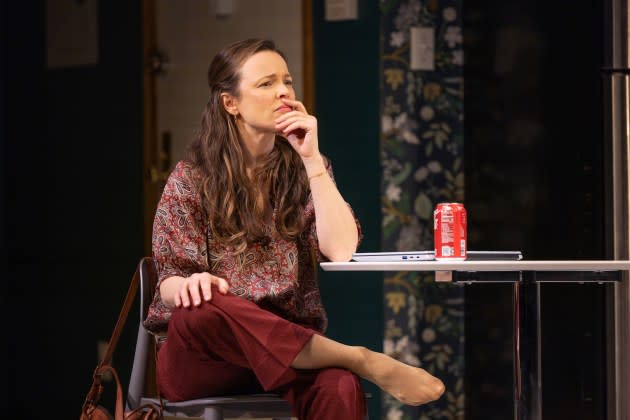‘Mary Jane’ Review: Rachel McAdams Makes a Solid Broadway Debut Depicting the Sacrifice of Motherhood

Parenting inspires varying schools of thought. While some relish the tasks of caretaking, others speak candidly about the hardships of child-rearing, sharing the true realities of motherhood that have been glamorized over time. In “Mary Jane,” the 2017 play written by Amy Herzog and making its Broadway debut under Anne Kauffman’s direction, viewers witness both a young mother’s joy and her anguish as she works around the clock to keep her disabled toddler alive.
“Mary Jane” opens in Queens, New York. Mary Jane (Academy Award nominee Rachel McAdams) sits in the small kitchen of her one-bedroom apartment, speaking to her super, Ruthie (Brenda Wehle). While Ruthie plunges desperately into the clogged sink, Mary Jane chats aimlessly. As she drones on with an eerie cheeriness, desperate to fill in the dead air, it’s immediately apparent this is a rare opportunity for her to socialize. Though Ruthie initially attempts to indulge Mary Jane, pity takes over, and the older woman instead begins to advise her tenant on the wonders of good sleep hygiene and self-care. Even armed with her cloak of optimism, it’s apparent to everyone except Mary Jane that her emotional well-being is teetering on the edge.
More from Variety
As the 95-minute show progresses, the audience becomes oriented on Mary Jane’s world and gets up to speed on her son Alex’s condition. Mary Jane’s daily schedule revolves around medications, machines, timers and very little sleep. Alex has been assigned a fleet of night nurses, but Sherry (April Matthis), who has worked with the mother and son for the past year, is the most consistent and dependable. Her nurturing energy extends beyond the young boy to Mary Jane, making the trio a makeshift family.
Much of the story presses forward in this cramped front room where Mary Jane allows herself a mere handful of sleeping hours on her pull-out couch. Despite her reflections on Alex’s time at school and their neighborhood walks, Mary Jane’s home is her entire world. The play’s two interiors, the living room/kitchen combo and, later, the cold blandness of the stark white hospital designed by Lael Jellinek, effectively display how confining Mary Jane’s life has become. (Strangely, however, the apartment scenery fails to fully slide into the air at the end of the first act, letting it hover distractingly during the entire second act.)
All the actors in “Mary Jane” save for McAdams portray dual characters in the first two acts. The hair, makeup and costuming, credited to J. Jared Janas and Brenda Abbandandolo, respectively, work well. However, seeing these actors in new roles in Act Two is initially jarring and distracting — especially since Matthis goes from Sherry to the character of Dr. Toros using only a simple white coat to distinguish between the two. Still, Susan Pourfar, playing two women in positions similar to Mary Jane, and Lily Santiago, as Sherry’s niece Amelia and music therapist Kat, have roles that showcase the actors’ wealth of talent and agility.
Performances are solid throughout, though McAdams’ projection was muted at a recent performance. Still, it’s the story that truly drives “Mary Jane.” More often than not, the labor of child rearing lies heavily on the mother, who is frequently the primary parent, whether partnered or otherwise. As a single mom caring for a special needs child, the weight of Mary Jane’s existence and her adoration and love for her son are the anchors fortifying this narrative. By the time the final curtain on “Mary Jane” drops, the audience is fully immersed in the titular character’s experiences. McAdams masters her portrayal of a determined caregiver continually sitting in the uncertainty of worry, despite constantly leaning toward positivity.
“Mary Jane” stays with viewers long after they leave the theater. It raises worthy questions concerning motherhood, sacrifice, community and lack thereof. It’s a story about how much one person — in this case, one woman — should be expected to endure before bowing under the pressure.
Best of Variety
Sign up for Variety’s Newsletter. For the latest news, follow us on Facebook, Twitter, and Instagram.

 Yahoo News
Yahoo News 